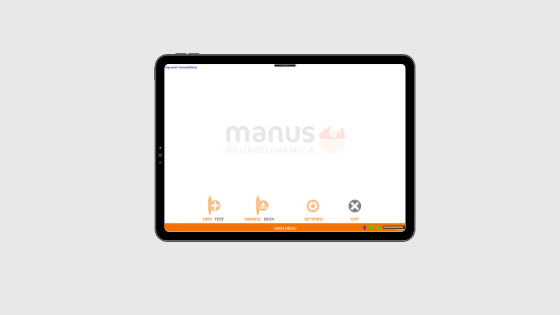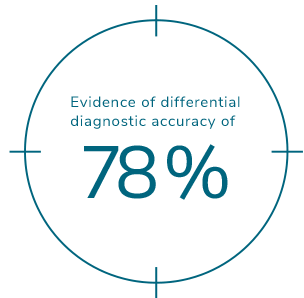The NeuroMotor PenTM (NMP) is a unique and patented system that combines sensor technologies built into a digital pen with software and an analytical engine with Decision Support System. The interface enables users to record non-invasively and analyse parameters of minute limb and hand motion. This enables quantification of fine motor skill. These parameters are used as ‘digital biomarkers’ to provide objective information about movement abnormalities. The NMP can be used to support diagnosis and monitoring of Parkinson's Disease (PD) and other neuromotor impairments. It has the potential to be a quick, inexpensive, non-invasive, and objective aid to diagnosis.
NMP may support specialist clinics with differential diagnostics at a time when only mild (early) symptoms are seen and the specialist is unable to make a definitive diagnosis [1].
First phase of clinical validation (from 2010)
The first phase of clinical validation has been completed in a total of 179 subjects with opinion leaders in Amsterdam, Dublin, Edinburgh, Groningen and Newcastle, and demonstrated:
- Specificity and sensitivity of 90% in early PD vs age-matched healthy controls [3,8,12].
- Accuracy of 80% (specificity and sensitivity of 80%) in differential diagnosis (Essential Tremor and other tremor/motor disorders vs PD) [11,12].
- Accurate quantification of motor skill for a degree of monitoring and rating medication effects, similar to the Purdue pegboard task. Pen motor skills scores matched standard clinical assessment scores, using the Unified Parkinson's Disease Rating Scale (motor-part-III-hand) [10].
- High reproducibility [4,5,6].
- Standardised drawing tasks for assessment [2,3,7,8,9].

Second phase of clinical validation (from 2015)
The NeuroMotor PenTM has since been further validated in 100 subjects against the current best practice diagnosis of clinical opinion (DaTSCAN) by Professor Walker, Parkinson’s Disease Clinical Lead for Northumbria Healthcare NHS Foundation Trust, in collaboration with five surrounding NHS Trusts: Gateshead health NHS FT, City Hospitals Sunderland NHS FT, Cumbria Partnership NHS FT, South Tees Hospitals NHS FT, and County Durham and Darlington NHS FT. The study demonstrated:
- In 100 undiagnosed patients for whom there was diagnostic uncertainty and DaTSCAN was required to confirm the diagnosis: A differential diagnostic sensitivity (PD vs not PD) of 80% and specificity of 75% of the NeuroMotor PenTM (overall accuracy of 78%) [13].

References
- Mitali Agarwal, Kate Vallely, Rutger Zietsma, Roman Bauer, William Gray, and Richard Walker. A Non-Invasive Aid for Diagnosis of Early Parkinson's Disease. Proceedings of International Congress of Parkinson's Disease and Movement Disorders (MDS), Hong Kong. 2018.
- Esther Smits, Antti Tolonen, Luc Cluitmans, Mark Van Gils, Bernard Conway, Natasha Maurits, and Rutger Zietsma. Standardized Handwriting to Assess Bradykinesia, Tremor and Micrographia in Parkinson’s Disease. Proceedings of 8th Fens Forum of Neuroscience, Barcelona, Spain. 2012.
- Esther Smits, Antti Tolonen, Luc Cluitmans, Mark Van Gils, Bernard Conway, Rutger Zietsma, Klaus Leenders, and Natasha Maurits. Standardized Handwriting to Assess Bradykinesia, Micrographia and Tremor in Parkinson's Disease. PLoS ONE E97614 9.5 (2014).
- Esther Smits, Antti Tolonen, Luc Cluitmans, Mark Van Gils, Rutger Zietsma, Marina Tijssen, and Natasha Maurits. Reproducibility of Standardized Fine Motor Control Tasks and Age Effects in Healthy Adults. Measurement 114 (2018): 177-84.
- Esther Smits, Antti Tolonen, Luc Cluitmans, Mark Van Gils, Bernard Conway, Rutger Zietsma, and Natasha Maurits. Reproducibility and Validation of Standardized Handwriting Tasks. Proceedings of 30th International Congress of Clinical Neurophysiology (ICCN) of the IFCN, Berlin, Germany. 2014.
- Esther Smits, Antti Tolonen, Luc Cluitmans, Mark Van Gils, Bernard Conway, Rutger Zietsma, and Natasha Maurits. Reproducibility and Validation of Standardized Handwriting Tasks. Proceedings of Society for Neuroscience (SfN), San Diego, California.
- Esther Smits, Antti Tolonen, Luc Cluitmans, Mark Van Gils, Bernard Conway, Rutger Zietsma, and Natasha Maurits. Standardized Handwriting Provides Quantitative Measures to Assess Bradykinesia, Tremor and Micrographia in Parkinson’s Disease. Proceedings of 16th International Congress of Parkinson's Disease and Movement Disorders (MDS), Dublin, Ireland. 2012.
- Esther Smits, Antti Tolonen, Luc Cluitmans, Mark Van Gils, Bernard Conway, Rutger Zietsma, and Natasha Maurits. Standardized Handwriting to Assess Bradykinesia, Tremor and Micrographia in Parkinson's Disease. Proceedings of 4th Dutch Bio-Medical Engineering Conference (BME), Egmond aan Zee, The Netherlands. 2013.
- Esther Smits, Antti Tolonen, Luc Cluitmans, Mark Van Gils, Bernard Conway, Rutger Zietsma, and Natasha Maurits. The Use of a Modified Fitts’ Task to Differentiate between Different Tremors. Proceedings of The XX Congress of the International Society of Electrophysiology and Kinesiology (ISEK), Rome, Italy. 2014.
- Esther Smits, Antti Tolonen, Luc Cluitmans, Mark Van Gils, Rutger Zietsma, Robbert Borgemeester, Teus Van Laar, and Natasha Maurits. Graphical Tasks to Measure Upper Limb Function in Patients with Parkinson’s Disease: Validity and Response to Dopaminergic Medication. 2015.
- Esther Smits, Antti Tolonen, Luc Cluitmans, Mark Van Gils, Natasha Maurits, and Rutger Zietsma. Distinguishing Parkinson's Disease from Other Syndromes Causing Tremor Using Automatic Analysis of Writing and Drawing Tasks. Proceedings of 15th International Conference on Bioinformatics and Bioengineering (BIBE), Belgrade, Serbia. 2015.
- Richard Walker, Rutger Zietsma, and William Gray. Could a New Sensory Pen Assist in the Early Diagnosis of Parkinson’s? Expert Review of Medical Devices (2014): 243-45.
- Rutger Zietsma, Roman Bauer, Antti Tolonen, Luc Cluitmans, Mark van Gils, Keith Gray, Richard Walker. The NeuroMotor Pen – an easily performed objective test of fine motor skill to support diagnosing Parkinson’s disease. Proceedings of the 3rd International Conference on Neurology and Brain Disorders, Valencia, Spain. 2019
Make a difference today
Our disruptive technology has the potential to be used across many applications such as screening, rehabilitation, drug development and medicine optimisation. We are keen to continue collaborating with interested researchers, clinicians and practitioners on our research in different areas of neuromotor disease, as well as investors for further development of our projects in the EU and US.

